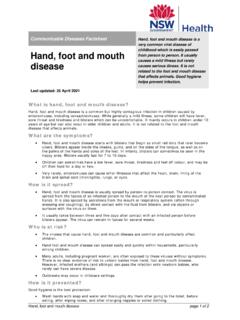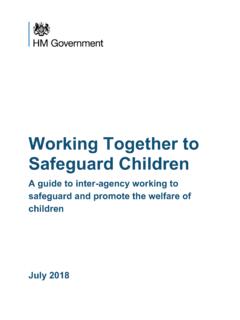Transcription of Key Person Positive relationships: Key people - part 1 ...
1 Key Person Positive relationships: Key people - part 1 - Handle with care Each child in a group setting must be assigned a key Person . In childminder settings the childminder is the key Person . A key Person has special responsibilities for working with a small number of children, giving them the reassurance to feel safe and cared for and building relationships with their parents.' So says Practice Guidance for the Early Years Foundation Stage, p15, All this sounds like good common sense, but what does it mean in practice? And how can settings make sure that their key persons approach is built on sound understanding of the importance of attachments and a real commitment to developing Positive relationships with children and their families? Key Person 'Key Person ' was the term used by Elinor Goldschmied and Sonia Jackson ( people Under Three - Young children in daycare, 1994) to describe pioneering work in nurseries that attempted to provide children with 'a Person to whom they can relate in a special way' (p37).
2 It is the particular nature and warmth of the relationship that marks the difference between a key Person and a 'key worker', whose main responsibilities are usually administrative and across multiple agencies. Each practitioner has a small group of children allocated to them, so that they can pay particular attention to the emotional and physical well-being of those children. Key Person approach The term 'key Person approach' is described in Key Persons in the Nursery (Peter Elfer, Elinor Goldschmeid, Dorothy Selleck, 2003) as an organisational method that ensures every child has 'one or two adults in the nursery, (who) while never taking over from the parents, connect with what parents would ordinarily do: being special for the children, helping them manage throughout the day, thinking about them too - all of which help a child to make a strong link between home and nursery'. Having a second Person as 'back-up' is important, as it is impossible to guarantee the availability of the key Person at all times.
3 Paired and shared key caring Sally Thomas (Nurturing Babies and Children Under Four) suggests using the term 'key caring' because it focuses on the relationship, rather than the role of the practitioner. She advocates 'paired and shared key caring' as a way of ensuring the very best attentive and nurturing care throughout a child's time in a setting. This partnership would ideally see an experienced practitioner matched with someone with less experience and the two would share the 'key caring' and remain the key people until the child left the setting. This key caring role means that the same adults take responsibility for the elements of a child's day that have the most impact on their emotional well-being. These include: - home visits and establishing good relationships with parents and families - handovers and transitions - greeting and settling children on arrival/farewells and smooth handovers at the end of sessions - personal care routines - meal times, nappy changing , toileting, rest times.
4 Well-being and development Without a key persons approach, a child is likely to be 'handled' by any number of staff during a session and over their time in the setting. If you have ever been in hospital, totally dependent on others for your care, you will probably know how stressful it is to be attended to by a range of different people , with no continuity of care or attention. Think how much worse that must be for a baby. Elinor Goldschmied urged us to never forget that 'a child, and particularly a young and almost totally dependent one, is the only Person in the nursery who cannot understand why he is there. He can only explain it as abandonment, and unless he is helped in a Positive and affectionate way, this will mean levels of anxiety greater than he can tolerate' ( people Under Three, p37). This is why the key persons approach isn't just about reducing the number of 'handlers' a child experiences.
5 Care routines, in particular, provide special times for key adults to relate to children in playful, affectionate ways that help build the secure attachments essential for children's well-being and brain development. As the relationship grows, the child's key people are better able to 'tune in' to their needs, their moods and enthusiasms and provide the intuitively nurturing responses that are essential if a child is to feel safe and secure. This doesn't mean, however, that a child is restricted to being just with either of their key people and the other children in their care. Feeling safe enough to explore and interact with others in the setting is very important, and more easily achieved when a child knows the security of being 'held in mind' by their key people . Secondary attachment This 'tuned in' relationship mimics in many ways the bonds of attachment that children have in their families.
6 However, it is essential to stress that in no way does it undermine the primary attachment a child has with a parent. It forms one of the several secondary attachments that a child needs to be able to thrive and cope when away from home. Challenges and implementation Often the objections to the key persons aproach focus on ways in which it is considered unrealistic, in terms of practitioner time and availability. A true key caring approach, however, doesn't attempt to achieve the impossible task of having one adult constantly available to the child. It seeks to minimise the amount of needlessly stressful situations that a child is exposed to. It cannot be denied that an approach that depends on quality relationships isn't easy to implement. Because it is an 'approach', rather than just an operational system, it isn't simply a matter of assigning groups of children to practitioners and managing rotas for care routines.
7 A huge amount of discussion and planning needs to take place before such an approach can get underway. Just as importantly, the discussion needs to continue over time, as the players in the key Person triangle - the children, their parents and the practitioners - overcome the challenges and build the relationships that bring benefits for everyone. Positive relationships: Key people - part 2 - Rest assured Implementing a 'key caring' approach may seem daunting, but practitioners need to understand its benefits for everyone, explains Anne O'Connor. A key Person has special responsibilities for working with a small number of children, giving them the reassurance to feel safe and cared for and building relationships with their parents.'. ( Positive Relationships , Key Person ). BENEFITS. The benefits of a 'key caring' approach can be profound. For babies and children, having a close and affectionate relationship with one or two adults who are responsive and emotionally available to them, away from home and family, provides the reassurance and comfort they need to feel safe.
8 Knowing they are cherished and 'held in mind' by their key people amid the hustle and bustle of daily life in a setting gives them the confidence to explore and develop independence. For parents, the approach makes sure that they also feel reassured and confident about their child's experience of being cared for away from home. It provides the opportunity to build a partnership with someone else who is fully committed to their child's well-being and, with the parents' help, will become familiar and 'tuned in' to their child's particular needs and motivations. For the key Person , the benefits from this intense and demanding approach are to be found in the satisfaction and fulfilment that comes from being someone who really matters to a child and their family, and who is recognised for their professional commitment and the impact that they have on a child's future development. For the setting, there are growing indications that increased practitioner involvement and job satisfaction not only reduces staff absence and turnover, but also leads to improved care and learning for children, and greater confidence and 'client satisfaction' among parents.
9 CHALLENGES. But what about the challenges? Implementing such an approach, and making sure it is done well, creates hard work for both managers and staff. Practitioners and parents alike have many real concerns about the challenges of key caring, and these are often used to justify a 'watered-down' approach, or downright resistance! However, most of these concerns stem from serious misunderstandings about the approach. For example: 'It is not possible to be available all the time for every child.' That's right, it isn't possible - not even for parents. But a true key-caring approach doesn't attempt to achieve the impossible task of having one adult constantly available to each child. It seeks, instead, to minimise the amount of needlessly stressful situations that a child is exposed to. And it is from the security of these safe relationships that a child learns that unavoidable separations, though sometimes painful, can be tolerated and managed.
10 'What happens when staff leave?' It is natural to worry that it is wrong to encourage children to attach to staff who might leave the setting before the child does. But the realities of life, and certainly of school later on, make this inevitable. Once again, the emotional well- being and security that comes from repeated experiences of being cared for and 'held in mind'. will help build the resilience and positivity that enable a child to cope with loss and transition. Also, having a partnership of two key carers, rather than just one, reduces the impact of individual key people leaving or being absent for any length of time. 'Children need to relate to other adults and children.' But the key people approach is not about restricting the child to one adult and a small group of children. The key carers provide a safe base which is built on a caring and affectionate relationship. When they have confidence in that relationship, children are better able to explore and interact with others, because they know reassurance and comfort are available whenever they need it.





